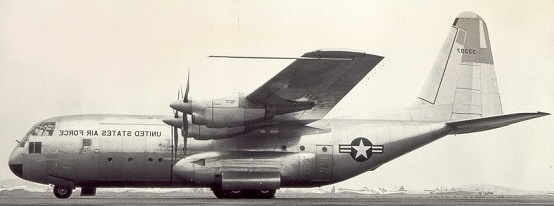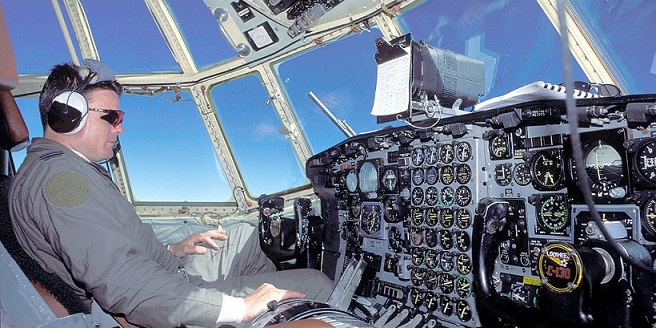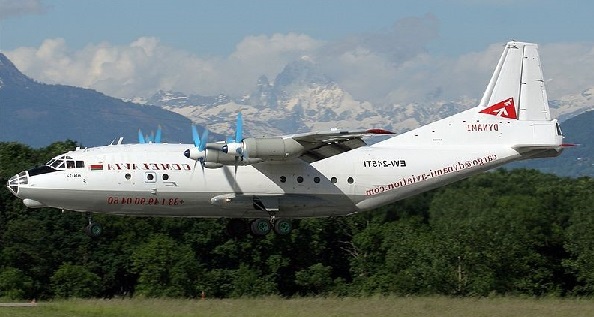Lockheed Martin C-130
The Lockheed Martin C-130 Hercules is about as bush planey as it gets, at least from a heavy lift, four screaming turboprop engine standpoint. The air force had cargo planes before the C-130 but the C-130 was the first plane that really put all the good features of the previous cargo planes into one dependable package. It featured a large rear cargo door and ramp, a high wing design and turboprop engines. It is very capable of landing on unimproved strips and has decent STOL performance for such a large aircraft.

Brief History of the C-130
While later cargo planes for the U.S. Air Force would feature jet engines (i.e. the C-141 and C-5), Airbus’ latest military cargo plane, the A400M Grizzly, features turboprop engines. The C-130 flew for the first time in 1954 and is still in production today. While the first plane produced in 1954 bears a striking resemblance to those being built today, they are, like the first and last Cessna 310s and Beech Bonanzas, substantially different aircraft. The airplane featured in the picture above is one of the first C-130s ever produced.
When the C-130 was first proposed, one Lockheed engineer—the legendary Kelly Johnson (of P-80, U-2 and SR-71 fame)--flatly stated that if the Hercules design was submitted to the United States Air Force, it would ruin the reputation of the Lockheed company. Kelly Johnson wasn’t wrong on many things relating to aircraft design and it was possibly one of his biggest gaffes. The C-130 went on to become Lockheed's highest selling aircraft and rocketed Lockheed to aviation stardom.

While the C-130 was envisioned primarily as a military aircraft, it has found suitable niches in a myriad of ways that go well beyond what can easily be told here. They have been used as gunships in Viet Nam, humanitarian relief aircraft and costal patrol aircraft just to mention a few roles they have served.
One thing that the C-130 really hasn’t been able to do was penetrate the civilian market to any great degree. This is partially due to the fact that often Lockheed’s production capacity was entirely taken up by military customers and the fact that the State Department limited potential customers of the C-130 because it didn’t want such an outstanding aircraft to fall into the wrong hands. Just imagine how horrid it would be if you were taking a leisurely stroll on Times Square only to have your day interrupted by a C-130 flying overhead tossing out leaflets denigrating capitalistic pig-dogs and what-not.
Despite the lack of sales to the civilian market, Lockheed-Martin has managed to produce nearly 3,000 Hercules as of the time of this article. Civilian C-130s are out there and one can easily buy a C-130 provided he or she really really is a successful capitalist pig-dog and the State Department does not object.

The earliest C-130s were powered by Allison T-56 turboprops that produced about 4,500 shp (shaft horsepower). Current C-130s like the one on the left are powered by Rolls Royce engines of only slightly more shaft horsepower.
The Soviets had two aircraft broadly comparable to the C-130, the Antonov An-10 and a further development of the An-10, the An-12. While these planes were credible rough and tumble cargo haulers in their own right, they weren’t up to snuff with the C-130. The An-10 was withdrawn from service due to structural weaknesses and the An-12 didn’t feature an integrated rear cargo ramp such as the C-130. Its back end opened up just like a C-130, but then a ramp had to be rolled into place—not a great feature for a plane that was designed to operate under combat conditions. The An-12 also wasn’t pressurized like the C-130 so when it hauled troops around, it was unnecessarily limited in its operating altitude. The An-12 looked a great deal like the C-130.

Unlike this An-12, C-130 lacked the rear gun turret. Even An-12 flying for the civilian airline Aeroflot often had rear gun turrets because how horrid it would be if you were toolin’ along in your An-12 all peaceful like when a capitalistic pig dog snuck up from behind and shot you right out of the sky? The rear guns were of dubious value because there were still plenty of angles to approach an An-12 to get a good shot if one was so inclined.

As the C-130 is a big, slow, 4 engine airplane it protects itself by dropping flares designed to confuse heat seeking missiles. Historically these types of flares were used to provide distraction and kind of like the precursor to infared light, used to illuminate enemy position. Modern warfare involves more effective countermeasures than the traditional flares but you still see the flare drop mainly in demonstrations and air shows. It enhances the photogenic quality of the airplane and is recognized as an icon of military pride and strength.
C-130 Fan Club
Mike from the US, who is currently in pilot training wrote in to tell us he thinks the the C-130 is the "holy grail" of bush planes. He also expressed some ideas he thought should be included on this website,
"Hey, I visited Alaksa This summer and heve a few planes I think you should look at. Other planes of interest are the C-27 (really a G222, a twin turboprop that will lift 12,000 ibs off a 1,500 ft runway) and the Casa Aviocar 212 (outwardly similar to a twin otter but with a rear cargo ramp, I know there is at least one in Alaska.) One the civilan side the Gippsland aeronautics GA-8 Airvan is an 8 seater designed to fill the gap between the cessna 206 and caravan. Built in Australia it was designed for use in the outback. The Montagne Mountain Goat STOL is similar to a Super Cub but was designed to legally haul the loads a Super Cub will overloaded."
Kirk, a pilot since 2002, wrote in to say, "I am a born and raised Alaskan, but i am struck here in Texas flying the good old Herk, go figure!"
We also heard from Nathan, a pilot for 8 years, who had this to say, "Thanks for including the C-130 as a Bush plane. I think the rough and tough pilot is a part of the description as well. Good luck finding a C-17 pilot that would spend the night in that "remote airfield" of Afghanistan. A lot of the airfields they fly into have been perfected by the only reliable platform in the region...the Mighty Battle Herk. Thanks for the great website. If you need some pics for the addition, let me know."
Thanks for your input, guys. Nathan, we would look forward to your photos.
By far the most colorful character we have heard from about the C-130 is Frank. He didn't say how long he had been flying but did mention he saw a pterodactyl on his first solo flight. That got a chuckle. Frank is retired and enjoys flying around New England in his Maule 7 260c. Prior to retirement, he hadn't flown since his combat missions. He flew the Jolly Green on search and rescue missions in Laos and North Vietnam. This alone tells me Frank is a bad ass and we should all be giving him a salute and thanking him for his service to our great country.
Frank had this to say, "You call the C-17 a stol. I was there for the development. It isn't stol. It can land short. But the gear isn't like a C-5 or Antonov so the field is trashed. Do three or four loads in and unless you're on a hardened surface (real runway or desert hardpan) and you've got plane killing ruts. Violates the stol rule we hardly every speak of - leave no damage. BTW if you tried to add that C-5 type gear then you'd lose way to much payload, become a hanger queen like the galaxy, etc. They should've just bought used 747s converted to cargo and expanded the c-130 fleet to support early operations. Instead your tax dollars went to converting the dc-10 to a c-17s making some district/company rich and some colonels into generals.
Told you he was colorful, didn't we? Frank also cast his vote on the best bush plane depending on the weight of the cargo load as follows:
Very light load - Aviat
Light load - Maule
Moderate load - Beaver
Heavy load - Twin Otter
Frank, we thank you and we salute you. It's been an honor to receive your input, Sir.
What is the Best Bush Plane?
Do you have a great story, an opinion, a tip or a review about this plane? Share it!
What Other Pilots Have Said:
Click below to see other pilot stories ....
Helio/Cessna 185 




What about rudder stalls? The C-130 can have stalled rudders? Is it serious?
Great Article Not rated yet
Very well written!!!
C-130 Not rated yet
My experience with the C-130 might be a bit unusual but true none the less. I had never flown in any aircraft, civilian or otherwise before stepping into …
For those who enjoy the historical side of aviation, Lockheed has an interesting article about their lost and found historical drawings and documents on their aviation archaeology page.

